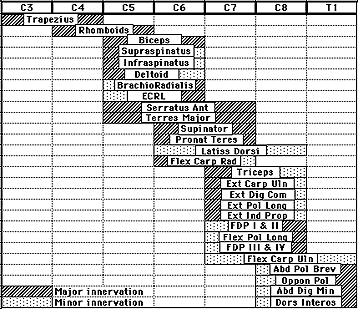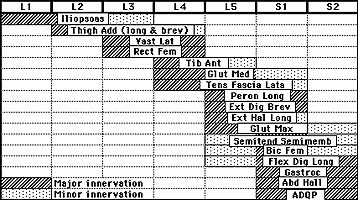Needle Examination Work-Ups
...
Fibrillations And Positive Waves
As in nerve conduction studies, a need exists in needle examination to develop broad-range work-ups designed for general groups of pathological processes. Along with that, a working knowledge of the spinal segments of the upper and lower extremities’ muscles is an absolute prerequisite for adequate interpretation of the needle examination.
A broad range work-up allows:
– A nonbiased approach to the patient’s problem leaving open the possibility that a disease other than the referral diagnosis may be found.
A simplified approach to general groups of diseases that can be tailored to fit the particular process at hand.
– Five general work-ups which are in general, similar but not identical to those described in the section on nerve conduction studies are thus described. They are: routine upper extremity, routine lower extremity, peripheral neuropathy, anterior horn cell disease, and myopathy.
Routine Upper Extremity
Designed for the study of roots, plexus, entrapment, and traumatic neuropathies of the upper extremity, this work-up emphasizes sampling of muscles belonging to different upper extremity nerves and innervated by root levels C5-T1.
The work-up consists of sampling the following (or other similarly innervated) muscles:
– The first dorsal interosseous (an ulnar C8, T1 muscle)
– The flexor pollicis longus (an anterior interosseous C7,8 muscle)
– The flexor carpi radialis (a median C7 muscle)
– The brachioradialis (a radial C5,6 muscle)
– The triceps (a radial C7,8 muscle)
– The deltoid (an axillary C5,6 muscle).
In the root lesions work-up, the appropriate paraspinal levels should be sampled.

Routine Lower Extremity
Designed for the study of roots, plexus, entrapment, and traumatic neuropathies of the lower extremity this work-up emphasizes sampling of muscles belonging to different lower extremity nerves and innervated by root levels L3-S2.
The work-up consists of sampling the following (or other similarly innervated) muscles:
– The extensor digitorum brevis or extensor hallucis longus (peroneal L5-S1 muscles)
– The flexor digitorum longus (a posterior tibial L5-S1,2 muscle)
– The tibialis anterior (a peroneal L4,5 muscle)
– The medial gastrocnemius (a posterior tibial S1,2 muscle)
– The vastus lateralis (a femoral L3,4 muscle)
– The gluteus medius (a superior gluteal L4,5 and S1 muscle)
In the root lesions work-up, the appropriate paraspinal levels should be sampled.

Peripheral Neuropathy
This work-up, which emphasizes distal muscles sampling because these are usually more involved in the typical neuropathic processes, consists of:
– A routine upper extremity examination with an extra distal muscle included, the abductor digiti minimi
– A routine lower extremity examination with the abductor hallucis included
Anterior Horn Cell
The main goal of this work-up is to sample muscles from a widespread root distribution to rule out the possibility of multiple motor radiculopathies. A minimum of two routine extremities work-ups need to be done.
These should include:
– A routine upper extremity
– A routine lower extremity
– A third upper or lower extremity depending on the areas of clinical involvement
– The tongue
Myopathy
For the study of the different groups of myopathies including the myotonias and the Lambert-Eaton syndrome, this work-up consists of modified routine upper and lower extremities studies with an emphasis on proximal muscles.
This should include:
– A modified routine upper extremity with the flexor pollicis longus deleted and the biceps and infraspinatus added
– A modified routine lower extremity with the flexor digitorum longus deleted and thigh abductors and iliacus added.
– In the inflammatory myopathies, the paraspinal muscles are usually quite involved and their sampling increases the diagnostic yield.
Neuromuscular Transmission
Single fiber EMG has greatly altered the traditional neuromuscular transmission defects work-ups by needle electrodes. Through moment to moment variation in the shape and amplitude of affected motor unit potentials is helpful, jitter analysis by single fiber EMG is a much more sensitive means to study defects in neuromuscular transmission. The technique requires the use of a special needle electrode which has a 25 µm tip on a side port to allow recording from single muscle fibers. When the tip is positioned in the vicinity of two muscle fibers belonging to the same motor unit, two potentials are seen firing synchronously. If, by means of a delay line and a signal trigger, one of them is made to trigger the sweep, the distance between the two potentials, or interpotential interval, is observed to vary from discharge to discharge. The distance between the first and second potential is measured over a certain number of tracings and the mean interpotential interval is calculated. The standard deviation around that mean or the mean of the consecutive differences (MCD) are used in expressing the jitter which to a large extent represents the variability in neuromuscular transmission. In neuromuscular transmission disorders, the jitter is increased early in the course of the illness, before repetitive stimulation tests become positive. In the later stages, impulse blocking due to total failure in neuromuscular transmission is seen and results in the disappearance of one of the potentials on the screen.
